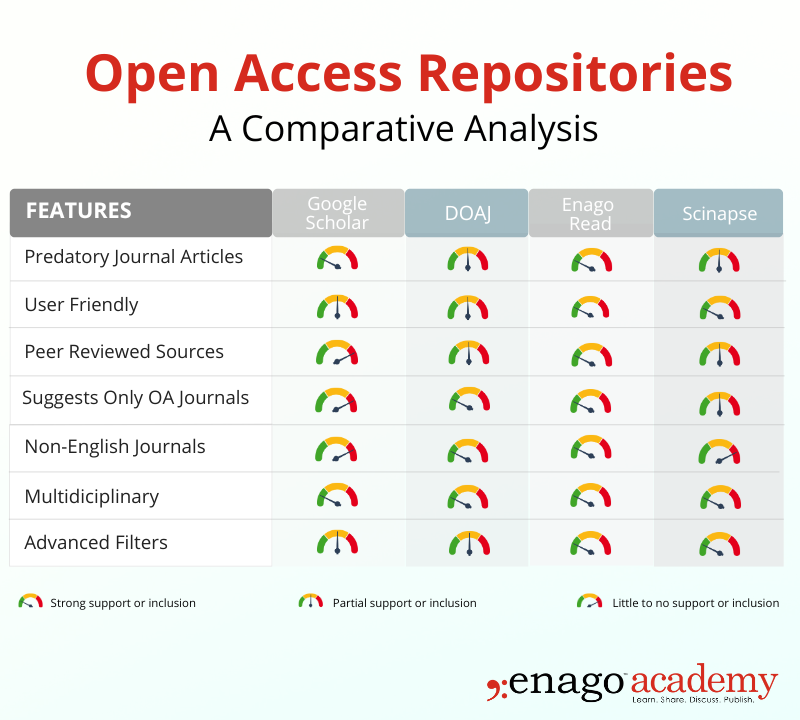Literature Review Made Simple: Comparing 4 open access repositories

The open access (OA) movement advocates for equitable knowledge sharing and facilitates access to academic research. It has revolutionized academia by removing paywalls, thereby improving access to scholarly works. OA enables researchers, students, and the general public to stay updated on global research advancements.
Researchers are increasingly choosing to publish their work in open access journals that can be indexed in open access repositories. This allows them to comply with grant requirements for public access and increases the visibility of their work. Furthermore, authors can be rest assured their work is safely archived and accessible to all.
Open Access Repositories
Open Access Repositories (OA Repositories) also known as Open Repositories are legal digital platforms that provide free, immediate, and permanent access to published academic work. OA repositories serve as centralized databases for high-quality publications, datasets, and supplementary materials.
Traditional repositories include institutional repositories at research libraries, subject specific repositories, and repository software. Examples of subject-specific repositories include media/rep/ (media studies), Social Science Open Access Repository (SSOAR) (social science), Centre of Excellence for Data Analytics (CEDA) Repository (environmental science), E-LIS (Library and Information Sciences), Aquatic Commons (food and agriculture), and PubMed Central (biomedical and life science). Repository software, such as Digital Commons, DSpace, EPrints, arXiv, and others have gained popularity after the open access movement.
Among all the repositories (traditional and AI-powered repositories) we have outlined the pros and cons of the ones that are widely used by academics in all disciplines. These points will help you choose the right repository that best suits your needs, as you effortlessly navigate OA-published research.
Google Scholar
Google Scholar is one of the most popular search engines among academics across various fields, encompassing approximately 200 million articles.
Pros:
- Intuitive searching using simple phrases
- Includes search results from multiple fields
- Allows filtering based on year of publication, type of article, relevance, authors, and journals
- Citation tracking and giving citations in different formats
Cons:
- Search results include gray literature and predatory journal articles
- Duplicate entries and inflated citation counts
- Some full-text links directed to articles behind paywalls
- Data privacy concerns related to search histories
- Lacks advanced filters and features like proximity searching
Directory of Open Access Journals (DOAJ)
The Directory of Open Access Journals (DOAJ) is a community-driven repository of open access journals that indexes over 10 million indexed articles.
Pros:
- Clean interface for easy navigation
- Covers journals across multiple disciplines
- Represents published research from 80 languages
- Indexes only free full-text articles
- Includes peer-reviewed academic literature
- Complies with the Open Archives Initiative Protocol for Metadata Harvesting (OAI-PMH).
Cons:
- Users must manually sift through results without AI-based categorization, which can slow down literature reviews
- Inconsistent metadata attribution
While traditional open access repositories have been the cornerstone accessing scholarly works, rapid advancements in AI are transforming the way we interact with data. The new generation of AI-powered tools leverages keywords and metadata to find relevant literature. These tools are being engineered to provide AI-based suggestions for exploring published research. Below, we have listed the features of a few popular AI-powered tools that you can explore.
Enago Read
Enago Read is an AI-powered research discovery tool that provides access to over 200 million articles. It features an interactive assistant for guided exploration and fosters a distraction-free environment for focused academic reading.
Pros:
- User-friendly interface
- Inclusion of peer-reviewed literature from various disciplines
- Includes articles from multiple languages
- Exclusion of predatory journals
- Availability of full-text articles for free
- AI-powered reviewing assistant
- Generates section-wise summaries and insights
- Shows relevant related articles
- Advanced filtering options
- Citation tracking and generation in different styles
- Allows collaboration and note-making
- Privacy with robust security protocols
Cons:
- The free version of the tool has limited access to all its features
- New users might need time to familiarize themselves with the platform’s features.
Scinapse
Scinapse includes over 174 million papers and uses advanced AI algorithms to find relevant research papers.
Pros:
- User-friendly interface
- Includes multidisciplinary literature
- Several sign-in options
- Advanced filtering options
- Citation tracking and generation in different styles
- Automated PDF compilation in literature
- Shows impact factor and h-index score in the search results
- Find experts and trends in a field
- Allows collaborative projects
Cons:
- May include literature from predatory journals
- Not all articles are freely available
- Requires a premium membership to access all features
- Recommendations may favor more popular or frequently cited papers, potentially overlooking less mainstream but valuable research.

Every repository provides features that can improve an academic review. While tools like Enago Read and Scinapse allow organization and summarization of references, repositories like Google Scholar and DOAJ cover a broad range of sources and support multilingual content.
However, each repository has its limitations. Some raise privacy concerns, while others include gray literature, predatory journals, and on-peer-reviewed content. Most of these shortcomings can be overcome by using multiple tools for a comprehensive literature review.
Additionally, the new generation of OA repositories aims to streamline academic research. These repositories aim to enhance secure access to peer-reviewed content while fostering collaborative research and advancing societal progress.









